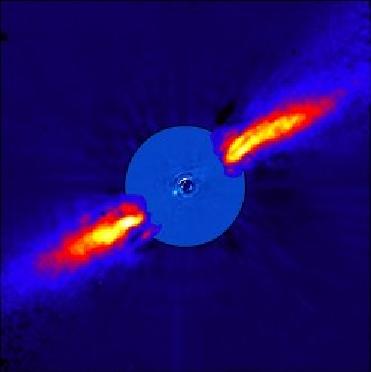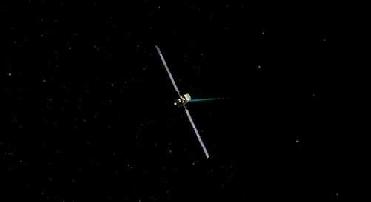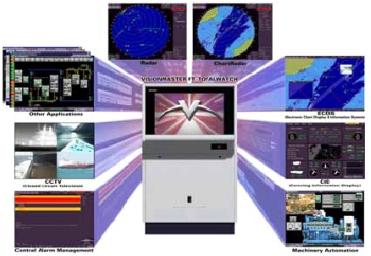
This composite image shows the close environment of Beta Pictoris star as seen in near-infrared light. Credit: ESO Image
PARIS (BNS): Astronomers have discovered an object, suspected to be a giant planet close to star Beta Pictoris, with the help of ESO�s Very Large Telescope (VLT).
The French astronomers believed that with a projected distance from the star of only eight times the distance between Earth and Sun, this object is most likely a giant planet suspected from the peculiar shape of the disc and the previously observed infall of comets onto the star.
"It would then be the first image of a planet that is as close to its host star as Saturn is to the Sun," the ESO said.
The astronomers said the object apparently lies inside the disc. They said the only 12 million years old, 'baby star' Beta Pictoris is located about 70 light-years away towards the constellation Pictor (the Painter).
Team leader Anne-Marie Lagrange said these are indirect, but telltale signs that strongly suggest the presence of a massive planet lying between 5 and 10 times the mean Earth-Sun distance from its host star. "However, probing the very inner region of the disc, so close to the glowing star, is a most challenging task," she said.
According to the European Southern Observatory, the hot star Beta Pictoris is one of the best-known examples of stars surrounded by a dusty 'debris' disc. Debris discs are composed of dust resulting from collisions among larger bodies like planetary embryos or asteroids. They are a bigger version of the zodiacal dust in the Solar System. Its disc was the first to be imaged as early as 1984 and remains the best-studied system. Earlier, observations showed a warp of the disc, a secondary inclined disc and in falling comets onto the star.
In 2003, the French team used the NAOS-CONICA instrument (or NACO 1), mounted on one of the 8.2 m Unit Telescopes of ESO's VLT, to benefit from both the high image quality provided by the Adaptive Optics system at infrared wavelengths and the good dynamics offered by the detector, in order to study the immediate surroundings of Beta Pictoris.
The ESO said recently, a member of the team re-analysed the data in a different way to seek the trace of a companion to the star. Infrared wavelengths are indeed very well suited for such searches, it said.
"For this, the real challenge is to identify and subtract as accurately as possible the bright stellar halo. We were able to achieve this after a precise and drastic selection of the best images recorded during our observations," Lagrange said.
The strategy proved very rewarding, as the astronomers were able to discern a feeble, point-like glow well inside the star's halo. "To eliminate the possibility that this was an artefact and not a real object, a series of tests was conducted and several members of the team, using three different methods, did the analysis independently, always with the same success. Moreover, the companion was also discovered in other data sets, further strengthening the team's conclusion: the companion is real," the ESO said.
However, Lagrange added that the team's observations pointed to the presence of a giant planet, about eight times as massive as Jupiter and with a projected distance from its star of about eight times the Earth-Sun distance, which is about the distance of Saturn in the Solar System.
Another team member Gael Chauvin said one could not rule out definitively that the candidate companion could be a foreground or background object. "To eliminate this very small possibility, we will need to make new observations that confirm the nature of the discovery."
The French astronomers also looked into the archives of the Hubble Space Telescope but couldn't see anything. However, most possible foreground or background objects would have been detected, another team member David Ehrenreich remarked.
The fact that the candidate companion lies in the plane of the disc also strongly implies that it is bound to the star and its proto-planetary disc.
"Moreover, the candidate companion has exactly the mass and distance from its host star needed to explain all the disc's properties. This is clearly another nail in the coffin of the false alarm hypothesis," Lagrange added.
Team member Daniel Rouan said direct imaging of extra-solar planets is necessary to test various models of formation and evolution of planetary systems. "But such observations are only beginning. Limited today to giant planets around young stars, they will in the future extend to the detection of cooler and older planets, with the forthcoming instruments on the VLT and on the next generation of optical telescopes."
 Next Article
Next Article













The Indian Air Force, in its flight trials evaluation report submitted before the Defence Ministry l..
view articleAn insight into the Medium Multi-Role Combat Aircraft competition...
view articleSky enthusiasts can now spot the International Space Station (ISS) commanded by Indian-American astr..
view article